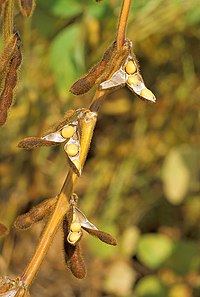
A High‐Performance Bio‐Adhesive Using Hyperbranched Aminated Soybean Polysaccharide and Bio‐Based Epoxide
Sign Up to like & getrecommendations! Published in 2020 at "Advanced Materials Interfaces"
DOI: 10.1002/admi.202000148
Abstract: Wood adhesives fabricated from biomass can substitute formaldehyde‐based ones, reducing the consumption of fossil resources and eliminating formaldehyde pollution. In this study, a novel and sustainable water‐soluble soybean polysaccharide (WSSPS)‐based adhesive is designed. Specifically, a… read more here.
Keywords: soybean; soybean polysaccharide; bio based; hyperbranched aminated ... See more keywords

Assessing irrigation water use efficiency and economy of twin‐row soybean in the Mississippi Delta
Sign Up to like & getrecommendations! Published in 2020 at "Agronomy Journal"
DOI: 10.1002/agj2.20321
Abstract: Em Abstract Twin-rowplanting in soybean ( L.) has been proposed for optimizing Glycinemax resource use and seed yield. Experiments were conducted in and on a Dundee silt loam to assess soybean seed yield… read more here.
Keywords: seed; soybean; irrigation; use ... See more keywords

Transgenic soybean plants expressing Spb18S dsRNA exhibit enhanced resistance to the soybean pod borer Leguminivora glycinivorella (Lepidoptera: Olethreutidae).
Sign Up to like & getrecommendations! Published in 2018 at "Archives of insect biochemistry and physiology"
DOI: 10.1002/arch.21461
Abstract: The soybean pod borer [SPB; Leguminivora glycinivorella (Mats.) Obraztsov] is a major soybean pest in northeastern Asia. A useful method for addressing this problem is the generation of transgenic plants producing double-stranded RNA (dsRNA) that… read more here.
Keywords: soybean; expressing spb18s; pod borer; transgenic soybean ... See more keywords

The effects of acetamiprid multigeneration stress on metabolism and physiology of Aphis glycines Matsumura (Hemiptera: Aphididae).
Sign Up to like & getrecommendations! Published in 2022 at "Archives of insect biochemistry and physiology"
DOI: 10.1002/arch.21903
Abstract: Aphis glycines Matsumura (Hemiptera: Aphididae) is a major soybean pest that often poses a serious threat to soybean production. In this study, we checked the effects of acetamiprid on redox, energy metabolism, and hormone expression… read more here.
Keywords: hormone; physiology; glycines matsumura; activity ... See more keywords

Pressurized liquid extraction of oil from soybean seeds
Sign Up to like & getrecommendations! Published in 2017 at "Canadian Journal of Chemical Engineering"
DOI: 10.1002/cjce.22922
Abstract: The aim of this study was to investigate the extraction of soybean oil using ethanol under pressurized conditions. The effects of pressure (10 and 20 MPa), temperature (30 to 90 °C) and solvent flow (1 and 3 mL/min)… read more here.
Keywords: extraction; soybean; temperature; pressurized liquid ... See more keywords

Nitrogen uptake and transfer in a soybean/maize intercropping system in the karst region of southwest China
Sign Up to like & getrecommendations! Published in 2017 at "Ecology and Evolution"
DOI: 10.1002/ece3.3295
Abstract: Abstract Nitrogen (N) deficiency occurs in over 80% of karst soil of southwest China, which restricts regional agricultural production. To test whether N fixed by legumes becomes available to nonfixing companion species, N fluxes between… read more here.
Keywords: transfer soybean; soybean maize; soybean; southwest china ... See more keywords

Silicon mitigates the negative impacts of salt stress in soybean plants.
Sign Up to like & getrecommendations! Published in 2023 at "Journal of the science of food and agriculture"
DOI: 10.1002/jsfa.12503
Abstract: BACKGROUND Soybean is widely cultivated around the world, including regions with salinity conditions. Salt stress impairs plant physiology and growth, but recent evidence suggests that silicon (Si) is able to mitigate this stressful condition. Therefore,… read more here.
Keywords: application; growth; stress soybean; soybean plants ... See more keywords

Recent update on methodologies for extraction and analysis of soybean seed proteins.
Sign Up to like & getrecommendations! Published in 2018 at "Journal of the science of food and agriculture"
DOI: 10.1002/jsfa.9235
Abstract: Soybean is one of the best sources of plant protein. Development of improved soybean cultivars through classical breeding and new biotech approaches is important to meet the growing global demand for soybeans. There is a… read more here.
Keywords: seed; soybean; recent update; extraction analysis ... See more keywords

Use of aggregation pheromone traps increases infestation of adult Riptortus pedestris (Hemiptera: Alydidae) in soybean fields.
Sign Up to like & getrecommendations! Published in 2018 at "Pest management science"
DOI: 10.1002/ps.5046
Abstract: BACKGROUND An aggregation pheromone trap has been used for both monitoring and mass-capture of Riptortus pedestris (Fabricius) in soybean. As the trap's efficacy in reducing the pest population and crop damage is unknown, we evaluated… read more here.
Keywords: soybean; soybean fields; riptortus pedestris; aggregation pheromone ... See more keywords

Efficacy of afidopyropen against soybean aphid (Hemiptera: Aphididae) and toxicity to natural enemies.
Sign Up to like & getrecommendations! Published in 2019 at "Pest management science"
DOI: 10.1002/ps.5525
Abstract: BACKGROUND Soybean aphid, Aphis glycines (Hemiptera: Aphididae), remains the most significant soybean insect pest in the North Central Region of the United States. The sustainability of reliance on only a few insecticide groups for this… read more here.
Keywords: hemiptera aphididae; soybean; group; soybean aphid ... See more keywords

The role of genetically engineered soybean and Amaranthus weeds on biological and reproductive parameters of Spodoptera cosmioides (Lepidoptera: Noctuidae).
Sign Up to like & getrecommendations! Published in 2022 at "Pest management science"
DOI: 10.1002/ps.6882
Abstract: BACKGROUND In soybean fields containing insect and herbicide resistant genetically engineered varieties, some weed species have increasingly become difficult to be managed and may favor the population growth of secondary pests like Spodoptera cosmioides (Walker)… read more here.
Keywords: artificial diet; lepidoptera noctuidae; spodoptera cosmioides; soybean ... See more keywords